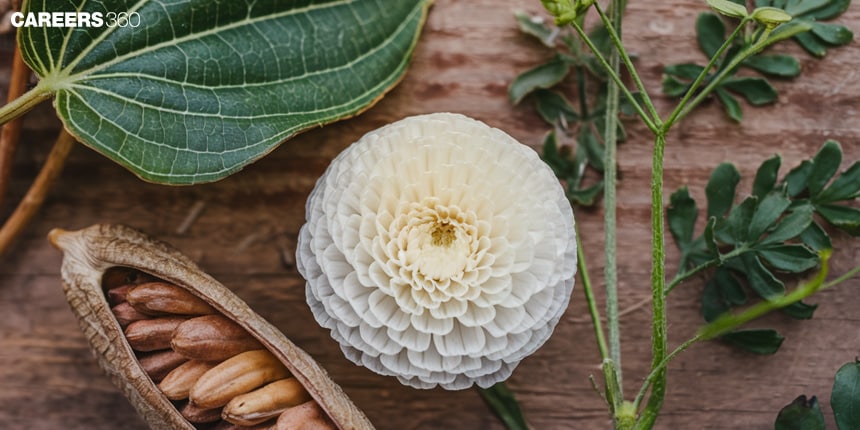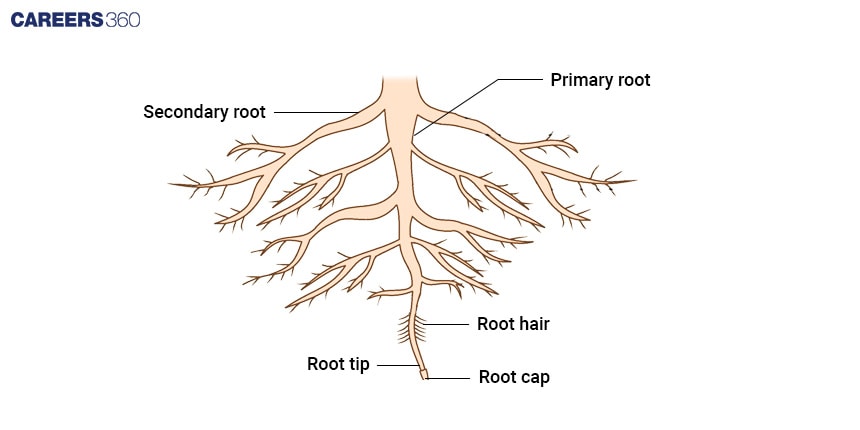Parts Of Plants: Overview, Diagram, Functions, chart
Parts Of Plants
A plant is a living organism under the kingdom Plantae which generally obtains its energy from sunlight through photosynthesis. Different parts of plants, like roots, stems, leaves, flowers, fruits, and seeds, are some of the things to be learned about a plant, since all these parts have crucial functions in the growth, reproduction, and survival of a plant.
NEET 2025: Mock Test Series | Syllabus | High Scoring Topics | PYQs
NEET Important PYQ's Subject wise: Physics | Chemistry | Biology
New: Meet Careers360 B.Tech/NEET Experts in your City | Book your Seat now
- Parts Of Plants
- Major Parts Of A Plant
- Recommended video on "Parts of Plants"

Roots fix the plant and provide it with water and nutrients; stems support the plant and carry nutrients; leaves are the prime photosynthetic organ; flowers allow for reproduction; and fruits and seeds allow propagation of the species. Hence, in a general understanding, knowledge of the parts of plants is central to applications in agriculture, botany, and environmental sciences, whenever one aims at securing optimal plant health and productivity.
Major Parts Of A Plant
The major parts of plants are explained below:
Root
Function:
The root's primary function is to absorb water and nutrients from the soil, provide anchorage for the plant on the ground, and store food and nutrients.
Types of Roots:
Tap-root: This is one thick primary root which grows deep into the soil, as in a carrot.
Fibrous root: It is a fine ramification of roots rising from the stem and growing obliquely outward in all directions close to the soil surface as in grass.
Adventitious Root: the root develops from the stems and branches and is not a direct continuation of the primary root, for example, a banyan tree.
Root Modifications:
Storage Roots: These are roots which act as nut storage organs, for example, sweet potato.
Adventitious Roots: These act as props to provide additional support, as in corn.
Aerial Roots: these roots lie exposed to air and can absorb moisture from the air, as in orchids.

Stem
Function:
The stem supports the plant, transports water and nutrients between the roots and leaves and sometimes stores some food and nutrients.
Types of Stems:
Herbaceous: Green, delicate, flexible stems. Example: Sunflower
Woody: stiff, solid stems, usually wholly covered with bark. Example: Oak tree.
Climbing: These are the stems that self-provide support but climb upwards only through other structures. Example: Ivy.
Structure:
Node: The point on the stem from which leaves, branches, or flowers originate.
Internode: That area of the stem between two nodes.
Axillary Bud: A bud that grows at the axil of a leaf and can develop into a branch or flower.
Stem Modifications:
Rhizomes: Horizontal underground stems that store nutrients and help in vegetative reproduction. Example: ginger.
Tubers: Swollen, fleshy underground stems that store food. Example: potato.
Runners: Above-ground horizontal stems that give rise to new plants from nodes, for example, strawberries.
Leaves
Function:
Photosynthesis: Leaves are the main parts of photosynthesis; which is the process the plants use to convert light energy into chemical energy.
Transpiration: Leaves help lose water vapour from the plant into the atmosphere. This is a cooling process and, through a pull, it helps in the flow of water and nutrients from roots to leaves.
Gas Exchange: Leaves bear stomata to allow the exchange of gases involved in photosynthesis, that is CO₂ in and O₂ out, and respiration.
Leaf Anatomy:
Blade: The flat, broad part of the leaf where most of the photosynthesis occurs.
Petiole: The stalk that attaches the leaf blade to the stem.
Veins: Vascular tissue within the leaf, comprising of xylem and phloem, which transport water, nutrients, and sugars.
Types of Leaves:
Simple: A single, undivided blade, for example, a maple leaf.
Structure: A leaf blade is further divided into many leaflets. For example, the rose leaf.
Leaf Modifications:
Tendrils: These are modified leaves or parts of leaves that assist climbing as in the pea plant
Spines: are modified leaves which reduce water loss and give protection as seen in cacti.
Flower
Function:
The flower is the reproductive structure in angiosperms, flowering plants. The flowers help in producing seeds via the pollination and fertilization processes.
Flower Structure:
Petals: They are usually coloured the attract pollinators.
Sepals: They are green leafy coverings that protect the young flower.
Stamen: These are the male reproductive organs; they consist of an anther and filament. The anther produces the pollen, and the filament supports the anther.
Pistil: This is the female reproductive organ. It is made up of stigma, style, and ovary. The stigma receives the pollen, and style connects the stigma to the ovary. The latter is made up of the ovules that develop into seeds after fertilization.
Types of Flowers:
Complete: This has all four main parts of the flower, namely petals, sepals, stamens and pistils.
Incomplete: Lack of either one or more of the four main flower parts.
Perfect: it contains both the male and female reproductive structures. Meaning it has both stamens, which is the male organ and pistils, which is the female organ.
Imperfect: Either missing stamen or pistils, meaning it's either male or female
Flower Modifications:
Inflorescence: A cluster of flowers on an axis to enable pollination and reproduction, thus enhancing reproduction. Examples are sunflower head and wheat spike.
Fruit
Function:
Protection and Dispersal of Seeds: Fruits protect the seeds during development and thus provide for their dispersal for example by being eaten by animals or carried by the wind.
Types of Fruits:
Simple Fruits: It develops from a single ovary of a single flower. Examples include an apple and a cherry.
Aggregate Fruits: It develops from multiple ovaries of a single flower. Examples include a raspberry and a strawberry.
Multiple fruits: Originate from the ovaries of more than one flower which grow simultaneously in a group. Examples: pineapple, fig
Fruit Structure:
Pericarp: The pericarp is derived from the wall of the ovary. It is made of three layers well defined:
Exocarp: This is the outermost layer that constitutes the skin of the fruit.
Mesocarp: The middle layer is fleshy and edible in most fruits.
Endocarp: It is the innermost layer and surrounds the seeds. It can be hard, as in stone fruits like peaches or membranous, as in apples.
Seeds: These are the reproductive units enclosed within fruits, which grow into new plants.
Seed
Function:
Seeds are how flowering plants reproduce. They contain an embryo that will develop into a new plant, typically with some means for dispersal, such as by wind, water, or animals.
Seed Structure:
Seed coat: outer protective covering protecting the seed from mechanical damage and disease.
Cotyledons: The embryonic leaves that provide nourishment to the developing embryo. There is one in monocots and two in dicots.
Embryo: Young plant contained within a seed; made up of root, hypocotyl, and plumule.
Types of Seeds:
Monocot Seeds: One cotyledon per seed; corn, and wheat are examples
Dicot Seeds: Two cotyledons per seed; bean, and pea are examples.
Recommended video on "Parts of Plants"
Frequently Asked Questions (FAQs)
The six basic parts into which a plant is primarily divided are the roots, stem, leaves, flowers, fruits, and seeds. All these parts fulfil certain functions and are essential in the growth, reproduction, and survival of a plant.
The roots help the plant in taking up water and nutrients from the ground, firmly anchoring the plant to the ground, and sometimes storing food and nutrients.
It supports the plant and holds the plant upright. Apart from this, it is involved in the transportation of water, nutrients, and sugars from roots to leaves. A storage site for nutrition is also provided.
The leaves are essential to the photosynthetic function, which is the process by which plants take energy from the sun. In addition, they serve as the site for gas exchange and transpiration, the mechanisms of regulating the loss of water.
Fruits can be of many different types. Types are as follows:
Simple Fruits: They are developed from one ovary. Example: cherry, tomato.
Aggregate Fruits: They develop from the ovaries of one flower. Examples: strawberry, raspberry.
Multiple Fruits: They develop from the ovaries of many flowers growing in a cluster. Example: pineapple.
Also Read
29 Nov'24 01:36 PM
18 Oct'24 04:39 PM
19 Sep'24 11:47 AM
19 Sep'24 11:02 AM
18 Sep'24 06:54 PM
18 Sep'24 06:14 PM
30 Aug'24 10:07 AM
30 Aug'24 06:20 AM